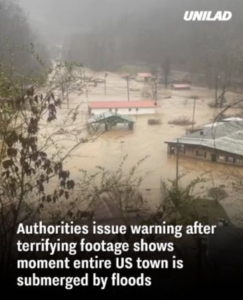In recent days, the United States has been grappling with a series of severe weather events that have led to catastrophic flooding in multiple regions. One of the most affected areas is Kentucky, where unprecedented rainfall has resulted in entire towns being submerged, prompting authorities to issue urgent warnings to residents.
The deluge began over the weekend, with relentless downpours causing rivers and streams to overflow their banks. The rapid rise in water levels caught many communities off guard, leading to widespread evacuations and emergency rescues. In some areas, residents were forced to seek refuge on rooftops as floodwaters inundated homes and businesses.
Tragically, the floods have claimed multiple lives. In Kentucky alone, at least eight fatalities have been reported due to the severe flooding. The relentless rain has also triggered mudslides, further endangering communities and complicating rescue efforts. Emergency responders have been working tirelessly, conducting approximately 1,000 rescues to save individuals trapped by the rising waters. The situation has become so dire that a state of emergency has been declared in Kentucky, as well as in Obion County, Tennessee, where a levee failure prompted mandatory evacuations.
In addition to the immediate dangers posed by the flooding, there are growing concerns about the aftermath. Contaminated water supplies, damaged infrastructure, and the potential for waterborne diseases are pressing issues that authorities are striving to address. Residents are being cautioned to avoid contact with floodwaters, which may be tainted with hazardous materials or sewage.
The severe weather is not confined to Kentucky and Tennessee. In Los Angeles County, California, recent heavy rains have led to significant mudslides and flooding, particularly in areas previously devastated by wildfires. The loss of vegetation due to fires has left the soil unstable and more susceptible to erosion, exacerbating the impact of the heavy rains. Neighborhoods in Malibu, the San Fernando Valley, and the San Gabriel Valley have been particularly hard-hit, with roads rendered impassable and homes damaged by the cascading mud.
The National Weather Service has issued multiple warnings, highlighting the life-threatening nature of the current conditions. A polar vortex is expected to bring “life-threatening cold” temperatures across the Rockies and northern Plains, with parts of Montana predicted to experience temperatures as low as -45 degrees Fahrenheit. This follows a weekend of severe weather in the eastern U.S. that resulted in ten deaths, nine in Kentucky due to flooding. President Trump has approved disaster relief for the state.
In response to the widespread devastation, local, state, and federal agencies are coordinating relief efforts. Shelters have been established for displaced residents, and the National Guard has been deployed to assist with search and rescue operations. Authorities are urging those in affected areas to remain vigilant, adhere to evacuation orders, and stay informed through official channels.
The recent events serve as a stark reminder of the unpredictable and often destructive power of nature. Communities across the nation are now faced with the daunting task of rebuilding and recovering from the aftermath of these catastrophic floods.


